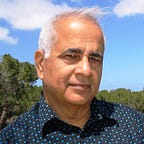Khushq Paratha
J.V. Yakhmi
The government of Karnataka state in India has recently proposed to charge 18% GST on ‘parathas’, as against just 5% on ‘rotis’. Both these items are typical North Indian flat-breads, though a paratha is an interleaved one with layers inside, cooked with ghee and often has a filling.
My mind goes back to 1970, when I, with some colleagues went to Madurai, a large city of Tamil Nadu state in South India, to attend a week-long Symposium. The organizers served good food, but it was totally southern fare. After 2–3 days, some North Indians like me got saturated and felt the urge to eat parathas. A nearby restaurant was passing off deep fried ‘chapattis’ (another variety of rotis), as parathas, which we rejected. North Indian dishes had not found a foothold till then in South India, and vice versa. We asked a cycle-rickshaw driver to take us to a Punjabi restaurant. He took us about 3 km in his rickshaw, and pointed to a first floor restaurant. It turned out to be a Gujarati restaurant. Apparently, the rickshaw driver didn’t know the difference between a Punjabi restaurant and a Gujarati restaurant, fifty years ago. We took dinner there all the same, having no other choice.
A simple ‘onion’ paratha with a mango pickle, and curd (yoghurt) to go with
We Punjabis (i.e. those belonging to the North Indian state of Punjab), consider parathas as an integral part of a sumptuous meal. And there is a wide choice of fillings in parathas — methi (green leaves of fenugreek), aalu (potato), mooli (white radish), onion, etc. each finely-chopped and mixed with the dough, from which the parathas are rolled out and cooked using generous amounts of ghee/butter. Ashutosh, my nephew from Delhi, likes a paratha having a layer of sugar grains inside, which should remain crunchy while eating. Obviously, this ‘Meetha’ (sweet) paratha needs some skill to make over low heat, while avoiding overcooking, lest it melts the hidden layer of sugar crystals in it.
I recall that in mid-1960s, a small dhaba just outside the boundary wall of Satpura Hostel of IIT, Delhi would offer hungry students a nutritious ‘omelet paratha’, which was unique since looking from one side it was a round omelet, but the obverse presented a buttered chapatti.
Droves of North Indian students would take admissions in Karnataka, in 1990s, to graduate from private professional colleges, which were non-existent then in North Indian states. My nephew, Manu, from Patiala in Punjab state, and his hostel-mates in a dental college in Davanagere would often hire an auto-rickshaw to go to a popular ‘dhaba’ (a road-side Punjabi restaurant) about 10 kms away, to eat parathas when they felt homesick for Punjabi food.
It was in the year 1960, when my maternal aunt (Maasi), having a large family to attend to under limited financial means, would cook parathas only for boys in the family. Girls were given chapattis, instead. Why? Because mothers were conscious that their young daughters may become obese, if fed on parathas. But how to explain this to her 6-year daughter Asha, who also wanted a paratha? Maasi didn’t want to break the rule but decided to circumvent the restriction by declaring that Asha will get a ‘khushq’ paratha. After much anticipation, we discovered that it just had the shape and interleaving, but no ghee was used in making it, hence the name ‘khushq’ (devoid of fat, dry). Nonetheless, Asha felt privileged, to get it, day after day, exclusively!
Over the years, parathas have gained popularity in all corners of India, and even in places like Birmingham or Toronto where there is a large Indian population. Many non-Punjabis attribute the girth of Punjabis to the fat-rich parathas they consume.
Parathas are now sold as a popular item at restaurants everywhere in India. You can even ask for a specialty paratha known as Lachha paratha, in a restaurant anywere in India, and chances are you would get it, even if after a delay of some minutes, needed to gather the ingredients and cook it.
The famous Indian English newspaper, The Hindu, recently published an article, describing how Merinda Vijayan, a 20-year-old undergraduate Commerce student helps her mother run a food stall near Thrissur in Kerala (India), by cooking nearly 150 flaky parathas everyday, for selling to local clients or hungry passers-by, to supplement their meager income.
